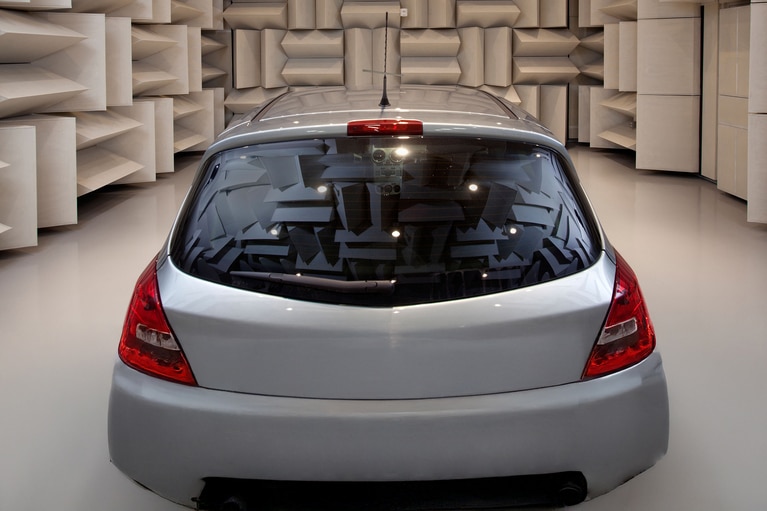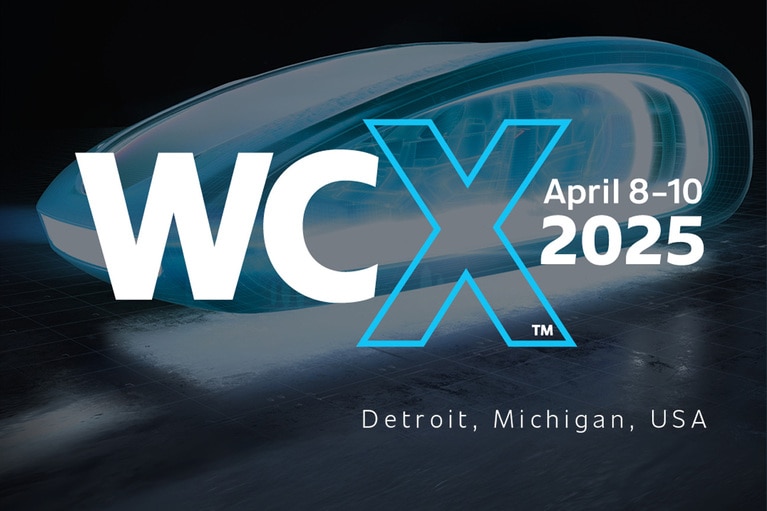By Greg Green, Director of Automotive Marketing
Innovative modules enhance efficiency and reduce complexity in EV applications
The electrification of the automobile is presenting new challenges for power system designers in achieving the highest power density at the lowest weight possible, eliminating compromises in vehicle range and overall performance. Designers of power delivery networks (PDNs) are also tasked with designing safe, efficient and lighter weight system, without impacting cost – a very tall order.
Using DC-DC converter power modules with industry-leading power density and innovative architectures equips power designers with solutions to reduce vehicle weight, power system space and overall cost. A fully optimized PDN using 48V zonal architecture and high-density power modules will provide up $100 in cost savings and up to 25kg (55 lbs) in weight reduction.
Figure 1: Replacing conventional, discrete power conversion with power modules throughout the vehicle provides significant cost and weight savings in EVs.
Power modules enable rapid scalability and flexibility
Power modules can unlock significant new power system design opportunities enabling rapid innovation, when compared to custom, ground up, discrete power designs. Three new automotive grade Vicor DC-DC power modules can enable rapid power scaling and faster power system design across platforms and applications providing the vehicle team with solutions that are flexible, scalable and reusable. The BCM6135, DCM3735 and PRM3735, leverage the long Vicor heritage and leadership in power density and highly efficient power conversion. Just as important, their compact size and light weight make them an excellent choice for automobiles.
The three modules can be arranged in over 300 PDN configurations to support subsystems throughout the vehicle. The three parts can be used to convert 800V power supply to either 48V or 12V at power levels between 2 and 20kW, for virtually all high voltage power conversion needs. They are especially well suited to support the transition to 48V and 48V zonal architectures. Also, by leveraging their bidirectional capabilities, the modules are best able to support regenerative power loads as they are capable of changing current flow with the fastest current slew rates seen in the automotive industry. This product line has been developed and qualified for automotive use via the APQP process and will be rolling off new high-performance automobile assembly lines in the next 12 months.
Figure 2: Vicor BCM6135, DMC3735 and PRM3735 power modules have set a new standard for power density in the automotive industry. Collectively they solve complex conversion challenges with 800V, 400V, 48V and 12V systems for xEVs power systems.
Streamlining EV electrification with three parts
Vicor power modules support modular scaling with parallel array capability and are so small that they can be used in a wide variety of applications. These parts are the building blocks for electrifying and innovating today’s EV.
Fast transient response enables deletion of low voltage battery
The BCM6135 is a 2.5kW isolated BCM® Bus Converter which converts 800V to 48V in a package of 61 x 35 x 7.3mm. It the high-voltage BCMs. provides an industry-leading power density of 158kW/l. In addition to its power density, the BCM6135 has a current slew rate (di/dt) of 8MA/s. This performance is made possible by Vicor Sine Amplitude Converter™ topology and ZVS/ ZCS (zero voltage/zero current) switching control systems.
Power density of 300kW/l supports 48V zonal
The DCM3735 2.0kW DCM™ DC-DC Converter converts an unregulated 48V input into a regulated 12V power supply. The DCM3735 has wide input range compatible with a variety automotive applications. The output can be trimmed within a range to 8 – 16V and it has a power density of 300kW/ l and supports downstream conversion and regulation from the high-voltage BCMs.
Compact and highly efficient regulation for 48V zonal
PRM3735 is a 2.5kW PRM™ Regulator for 48V power supply. The PRM3735 provides regulation at an efficiency of 99.2%. It has a small footprint and 260kW/l power density that helps free up packaging space downsizing the overall DC-DC power supply.
These new modules help OEMs achieve important EV power system design objectives:
- Reducing size and weight: The power density of Vicor modules allows the size and weight of a DC-DC converter to be reduced by up to 50%, achieving industry leading power density. These Power density of 300kW/l supports 48V zonal The DCM3735 2.0kW DCM™ DC-DC Converter converts an unregulated 48V input into a regulated 12V power supply. The DCM3735 has wide input range compatible with a variety automotive applications. The output can be trimmed within a range to 8 – 16V and it has a power density of 300kW/l and supports downstream conversion and regulation modules can be used any variety of subsystem to save weight and space.
- Converting high voltage to SELV: Every EV starts with a primary battery (400V or 800V) that powers a myriad of subsystems. Converting to SELV is essential. Doing it efficiently while minimizing space and weight is the designer’s goal.
- Easily adopting a 48V zonal architecture: The EV presents a clean sheet for development of a more efficient PDN. Using a 48V-based PDN instead of 12V creates a more electrically efficient system, allowing the vehicle to dedicate more battery power to driving range. Miniature DC-DC converters make this transition very easy.
Power modules support broad automotive applications
The three new automotive modules serve as a Swiss army knife™ for power engineers. They can be used alone or in combination to streamline the design process and produce systems that are more efficient and lighter weight. So how are power modules being used today
- Active suspension comes of age in EVs
Today Hongfa, an automotive tier one supplier, is working with Vicor to develop 800V–48V DC-DC converters to support active suspension systems. Active suspension capitalizes on 48V delivery since power needs of this application exceed what 12V power can deliver. Furthermore, there are many safety concerns when routing 800V or 400V to multiple vehicle points. The active suspension system will take advantage of the BCM6135 power density to achieve a system box volume under 1.8l. This application also leverages the BCM6135 high slew rate for regenerative power loads, which require immediate current flow reversal to pass power back to the battery.
- Eliminating or reducing the low-voltage battery footprint
With the high-voltage primary battery in EVs today, downstream batteries can be expendable if there is a way to deliver robust transient performance. The industry-leading slew rate of the BCM6135 presents an opportunity to replace a 48V battery whereby the DCM6135 serves as virtual 48V battery in the xEV vehicle, delivering cost and weight savings. Since the BCM6135 can step from zero current to full current at a slew rate of 8.0MA/s, it can step down the traction battery’s 800 to 48V and power a load just as fast as drawing the power from an auxiliary 48V battery. No other DC-DC converter can match this speed and enables customers to reduce vehicle weight by up to 10kg while reducing vehicle costs.
- 48V zonal architecture adoption is on every roadmap
The move to 48V is gaining momentum and adoption is no longer optional. The new power modules can be easily configured to make this transition easier. The DCM3735 is used in conjunction with BCM3735 to create a regulated 12V power supply off the BCM6135 48V output.
As 12V power has been the industry default for over 60 years, there are still many loads in a vehicle that are designed for 12V power. These 12V devices are low cost and most importantly have demonstrated long term reliability. The transition to 48V has been impeded by the need to have both 12V and 48V power supply around the vehicle. The DCM3735 can be assembled on a common PCB with the BCM6135 to create a compact DC-DC converter, or it can be deployed as part of a 48V zonal architecture.
When used as a part of the 48V zonal architecture the DCM3735 can be mounted remotely to create a local 12V supply in a vehicle zone. This application method allows the PDN designer to effectively support 12V loads while achieving up to 90% of the cost and weight savings that are created when transitioning to a 48V bus.
- Pre-charging prevents current surges and saves weight
An alternative application of the BCM6135 takes advantage of the bidirectional ability of the BCM to provide a lower cost and lower weight process to pre-charge the high-voltage loads in the EV before the traction battery is engaged. Pre-charging is a necessary step of the start-up process, it prevents current surges at battery engagement that will damage the loads (such as pumps and compressors). Currently this is done using a high-voltage contactor and resistor, which add 1kg and over $50 in cost. The alternative is to use BCM6135 as the main DC DC converter and one of the low-voltage batteries installed in the vehicle. The BCM6135 can boost the low voltage battery power up to high voltage and achieve the needed pre-charge, eliminating the legacy pre-charge contactor and power resistor.
Figure 3: Combining a BCM6135 with 48V delivers optimal performance and reduces size and weight of the power system. Given the high slew rate and high efficiency of the BCM6135, the system can achieve almost the same bi-directional power transmission for regenerative power as a direct cable without needing to rely on an auxiliary battery or high-voltage cables.
High-density power modules create new possibilities for EV innovation
The electrification of automobiles is one of the most daunting design issues the automotive industry has ever faced. Adding battery cells and electronics balloon the vehicle weight and compromises range and performance. Designing with high-density power modules is the perfect solution for high-voltage conversion and to counter the impact of the heavy electronics.
Vicor, with its industry-leading power density, simplifies the job of the power engineer and helps stabilize the future xEV platforms using just three power modules: the BCM1635, DCM3735 and PRM3735. These compact products allow the PDN designer to downsize the hardware needed for DC-DC power conversion, leverage the smaller systems for integration into the battery or other power management boxes, and reduce the weight of the cooling system. Vicor modules also open the door not only to pioneering innovation, but also to definitive cost and weight savings. These three modules provide the basis for achieving up to $100 in cost reduction and reducing vehicle weight by up to 25kg.
Greg Green is the Director of Automotive Customer Programs at Vicor Corporation. He has over 33 years of experience in the automotive industry, spanning across manufacturing, design engineering and product line management with OEM’s, and Tier 1 suppliers. Greg’s auto industry experience includes manufacturing, product development, and business development. Greg holds a B.S. Degree in Aerospace Engineering from the University of Michigan, and an M.S. in Manufacturing Management from Kettering University.
Greg Green, Director of Automotive Marketing













